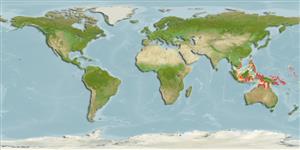Teleostei (teleosts) >
Gobiiformes (Gobies) >
Gobiidae (Gobies) > Gobiinae
Etymology: Tryssogobius: Greek, tryo, tryso = to wear away + see under Gobius; longipes: From the Latin longes, and pes for foot, in reference to the elongate pelvic fins, especially in developed males (Ref. 44093).
More on authors: Larson & Hoese.
Environment: milieu / climate zone / depth range / distribution range
Ecology
Marine; reef-associated; depth range 20 - 35 m (Ref. 90102). Tropical
Distribution
Countries | FAO areas | Ecosystems | Occurrences | Point map | Introductions | Faunafri
Western Central Pacific: Indonesia and Papua New Guinea.
Size / Weight / Age
Maturity: Lm ? range ? - ? cm
Max length : 2.1 cm SL male/unsexed; (Ref. 44093)
Short description
Identification keys | Morphology | Morphometrics
Dorsal spines (total): 7; Dorsal soft rays (total): 11; Anal spines: 0 - 1; Anal soft rays: 13 - 14. Grey with a yellow to orange lateral stripe, which may form a dark spot under the eye; black spot in the first dorsal fin (Ref. 44093); characterized further by having blue and yellow basal stripes on dorsal and anal fins; caudal fin with blue and yellow streaks/bands; pelvic fins white; third and fourth dorsal spines elongate in males; pointed caudal fin in adults; longitudinal scale series 27-28; cheek with a single row of large scales; opercle covered by 2-3 large scales; predorsal scales extending to mid-interorbital; fused pelvic fins, forms cup-shaped disc; depth of body 5.0-7.0 in SL (Ref. 90102).
Inhabits sand-rubble bottoms in 20-35 m (Ref. 90102). Hovers above the substrate (Ref. 44093).
Life cycle and mating behavior
Maturity | Reproduction | Spawning | Eggs | Fecundity | Larvae
Larson, H.K. and D.F. Hoese, 2001. A new genus of small gobiid fish (Teleostei, Gobiidae) from the Indo-west Pacific, with description of two new species. Beagle, Rec. Mus. Art Galler. North. Territ. 17:27-36. (Ref. 44093)
IUCN Red List Status (Ref. 130435: Version 2024-2)
Threat to humans
Harmless
Human uses
Tools
Special reports
Download XML
Internet sources
Estimates based on models
Preferred temperature (Ref.
123201): 26.8 - 28.7, mean 27.5 °C (based on 20 cells).
Phylogenetic diversity index (Ref.
82804): PD
50 = 0.5078 [Uniqueness, from 0.5 = low to 2.0 = high].
Bayesian length-weight: a=0.01023 (0.00477 - 0.02194), b=3.01 (2.83 - 3.19), in cm total length, based on LWR estimates for this (Sub)family-body shape (Ref.
93245).
Trophic level (Ref.
69278): 3.1 ±0.3 se; based on size and trophs of closest relatives
Resilience (Ref.
120179): High, minimum population doubling time less than 15 months (Preliminary K or Fecundity.).
Fishing Vulnerability (Ref.
59153): Low vulnerability (10 of 100).
